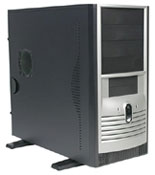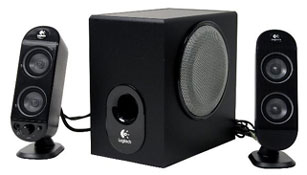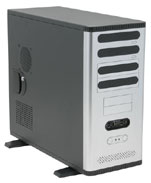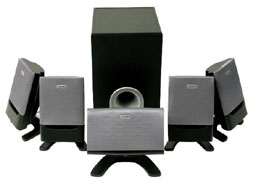Entry Level Buyer's Guide, October 2005
by Jarred Walton on October 14, 2005 12:05 AM EST- Posted in
- Guides
Miscellaneous Part Recommendations
We've covered the major components for a computer, and we'll finish by covering the storage, keyboard, mouse, sound, networking, case, and power supply choices. (That's a lot of choices left, but the impact on performance for most of them is negligible at best.) If you grab the cheapest parts for several of these options - input devices and speakers - then you can get the bare minimum of functionality. Depending on how much you plan on using the computer, though, we'd upgrade some options.
First, the keyboard and mice are how you actually communicate with the computer (unless you're planning on trying out some voice recognition software). If you're going to be using the computer for work, sitting at it eight hours a day, then do your body a favor and get a keyboard and mouse that are comfortable for long-term use. Ergonomic keyboards might help a bit if you have carpal tunnel problems or suffer from RSI (Repetitive Stress Injury). Of course, the truth is that the best way to combat such problems lies elsewhere: a good desk and chair combined with frequent breaks is critical for long-term comfort. The desk and chair can easily cost more than an entire computer; thankfully, upgrades are rare occurrences. We've given you a bit of advice on what you might want to consider, but the rest is up to you. As usual, we're going to recommend a standard keyboard/mouse combo from either Logitech or Microsoft.
Sound and networking devices are really easy to cover: use the integrated devices on the motherboard. Every modern motherboard includes both sound and network functionality. Is it the best sound that you'll ever hear from a PC? Hardly, but you probably won't care much. Networking performance is even less critical; unless you're planning on running gigabit Ethernet wiring, nearly all 10/100 network devices are close enough in performance that discussing it further amounts to splitting hairs.
For the speakers, at least for non-gaming use, just grab a $10 to $20 set (or use what you already have). If you need a truly cheap recommendation, you can get a pair of Logitech S-100 speakers for free with the purchase of a keyboard, courtesy of Newegg. It's tough to beat free (though we're really only saving $7). The sound quality just about matches the price, so if you want something where you could actually listen to a CD or even watch a DVD on your computer, you'll want to bite the bullet and at least get some speakers with a subwoofer. Small satellites simply can't produce bass well, and cheap satellites are even worse. Logitech's X-230 speakers run $37 shipped and provide a good minimum level of sound quality. We'll use those for the home/office setup, but for gaming, we'll upgrade to 5.1 speakers.
Office Components:
Gaming Components:
Most of the choices should be pretty self-explanatory, so we just want to touch on the important areas. First, our hard drive and optical drive selections are essentially a toss up. Our last Hard Drive Roundup showed that SATA 3.0Gbps drives were faster in some areas, and NCQ could help out in certain tests as well, but there was no clear victor. This is a budget guide, so price as well as $/GB are going to be the primary factors in what we select. Hitachi won out in both the 80GB and 160GB categories - we chose a larger drive for the gaming system, though in truth, you could put either drive in either configuration, depending on how you plan to use the PC. The less than 40 cents per GB cost of some Maxtor 250GB models also bears mention, but we aren't big fans of the MaxLine II models and wanted to keep the HDD cost under $100, so we didn't upgrade to a 200GB or larger drive. The 160GB choice will still provide plenty of room for games, videos, music, photos, and whatever else you might want. Combined with the ability to archive old data to DVDR discs, storage capacity shouldn't be a major concern.
The 5-year Seagate warranty (you can get a similar warranty on the more expensive Western Digital drives) is also something to consider, but warranties don't cover lost data. (You might want to wait for the new Seagate drives as well, if you're looking to get a Seagate anyway.) That's why a good backup strategy is important, and the DVDR drives provide that. Firmware updates to the NEC 3540A, BenQ DW1640, and Pioneer 110D drives have ironed out most of the media compatibility issues, so they pretty much tie for price, performance, and compatibility. NEC wins on total cost plus shipping right now, but prices can fluctuate daily, so feel free to choose one of the other models.
The case and power supply choices are certain to draw plenty of comments, as they did with the last budget guide. We actually picked up the MGE CAG-M1-BK with the 400W PSU that we listed to run it through some tests. The quick summary is that the case is flimsy and cheap, the front panel connectors feature individual connections for the USB and Firewire ports rather than a nice molded block, and as a whole, the case is underwhelming. For $65 shipped, though, it gets the job done. It's been running almost 24/7 for a couple of months without any problems, even when overclocking a Sempron to 2.60 GHz. Will the power supply fail at some point? Probably. With the overclocked Sempron and an X800 Pro, though, peak power draw is only hitting 190W or so. For a budget system, you really don't need to go out and buy a $75 PSU in order to run stable. Something else to consider is that since shipping costs about $15 for many cases when ordered online, you might just run down to your local computer shops to see what's available.
The Foxconn cases and power supplies that we chose for this month's gaming selections are of higher quality than the MGE, but they're still not high-end. The "office" selection is a bit cheaper and only includes a 300W PSU (which should be fine for the integrated graphics and other components). For the gaming case, the PSU has a 24-pin power connector (really, this time!), and it's also ATX2.0 compliant. Both have a relatively conservative look, and we like the more expensive model a bit more. It has spring-loaded optical drive doors on the top two 5.25" bays. The cases also include a 120mm fan mounted at the back and a CPU duct, which should easily handle our budget builds.
You may eventually need to upgrade the case a bit with a new PSU or a second fan, but with Intel's talk of performance per Watt, the next generation PCs may actually reduce power requirements. (Here's hoping...) We don't expect people to have problems with either of these cases, but if you start thinking about adding multiple hard drives, you might need a heftier PSU.
We've covered the major components for a computer, and we'll finish by covering the storage, keyboard, mouse, sound, networking, case, and power supply choices. (That's a lot of choices left, but the impact on performance for most of them is negligible at best.) If you grab the cheapest parts for several of these options - input devices and speakers - then you can get the bare minimum of functionality. Depending on how much you plan on using the computer, though, we'd upgrade some options.
First, the keyboard and mice are how you actually communicate with the computer (unless you're planning on trying out some voice recognition software). If you're going to be using the computer for work, sitting at it eight hours a day, then do your body a favor and get a keyboard and mouse that are comfortable for long-term use. Ergonomic keyboards might help a bit if you have carpal tunnel problems or suffer from RSI (Repetitive Stress Injury). Of course, the truth is that the best way to combat such problems lies elsewhere: a good desk and chair combined with frequent breaks is critical for long-term comfort. The desk and chair can easily cost more than an entire computer; thankfully, upgrades are rare occurrences. We've given you a bit of advice on what you might want to consider, but the rest is up to you. As usual, we're going to recommend a standard keyboard/mouse combo from either Logitech or Microsoft.
Sound and networking devices are really easy to cover: use the integrated devices on the motherboard. Every modern motherboard includes both sound and network functionality. Is it the best sound that you'll ever hear from a PC? Hardly, but you probably won't care much. Networking performance is even less critical; unless you're planning on running gigabit Ethernet wiring, nearly all 10/100 network devices are close enough in performance that discussing it further amounts to splitting hairs.
For the speakers, at least for non-gaming use, just grab a $10 to $20 set (or use what you already have). If you need a truly cheap recommendation, you can get a pair of Logitech S-100 speakers for free with the purchase of a keyboard, courtesy of Newegg. It's tough to beat free (though we're really only saving $7). The sound quality just about matches the price, so if you want something where you could actually listen to a CD or even watch a DVD on your computer, you'll want to bite the bullet and at least get some speakers with a subwoofer. Small satellites simply can't produce bass well, and cheap satellites are even worse. Logitech's X-230 speakers run $37 shipped and provide a good minimum level of sound quality. We'll use those for the home/office setup, but for gaming, we'll upgrade to 5.1 speakers.
Office Components:
 |
 |
| Click images to enlarge. | |
| Hard Drive: | Hitachi 3.0Gbps 80GB 7200RPM 8MB Deskstar 7K80 | $57 |
| Optical Drive: | NEC 3540A Black (OEM) | $41 |
| Case and Power Supply: | Foxconn 3GTH-002 plus 300W PSU | $70 |
| Speakers: | Logitech X-230 2.1 Speakers | $37 |
| Keyboard and Mouse: | Logitech Internet Pro Desktop | $23 |
Gaming Components:
 |
 |
| Click images to enlarge. | |
| Hard Drive: | Hitachi 3.0Gbps 160GB 7200RPM 8MB Deskstar T7K250 | $81 |
| Optical Drive: | BenQ DW1640 Black (OEM) | $46 |
| Case and Power Supply: | Foxconn TPS544-S350 plus 350W PSU | $82 |
| Speakers: | Labtec ARENA 685 5.1 Speakers | $47 |
| Keyboard and Mouse: | Logitech Internet Pro Desktop | $23 |
Most of the choices should be pretty self-explanatory, so we just want to touch on the important areas. First, our hard drive and optical drive selections are essentially a toss up. Our last Hard Drive Roundup showed that SATA 3.0Gbps drives were faster in some areas, and NCQ could help out in certain tests as well, but there was no clear victor. This is a budget guide, so price as well as $/GB are going to be the primary factors in what we select. Hitachi won out in both the 80GB and 160GB categories - we chose a larger drive for the gaming system, though in truth, you could put either drive in either configuration, depending on how you plan to use the PC. The less than 40 cents per GB cost of some Maxtor 250GB models also bears mention, but we aren't big fans of the MaxLine II models and wanted to keep the HDD cost under $100, so we didn't upgrade to a 200GB or larger drive. The 160GB choice will still provide plenty of room for games, videos, music, photos, and whatever else you might want. Combined with the ability to archive old data to DVDR discs, storage capacity shouldn't be a major concern.
The 5-year Seagate warranty (you can get a similar warranty on the more expensive Western Digital drives) is also something to consider, but warranties don't cover lost data. (You might want to wait for the new Seagate drives as well, if you're looking to get a Seagate anyway.) That's why a good backup strategy is important, and the DVDR drives provide that. Firmware updates to the NEC 3540A, BenQ DW1640, and Pioneer 110D drives have ironed out most of the media compatibility issues, so they pretty much tie for price, performance, and compatibility. NEC wins on total cost plus shipping right now, but prices can fluctuate daily, so feel free to choose one of the other models.
The case and power supply choices are certain to draw plenty of comments, as they did with the last budget guide. We actually picked up the MGE CAG-M1-BK with the 400W PSU that we listed to run it through some tests. The quick summary is that the case is flimsy and cheap, the front panel connectors feature individual connections for the USB and Firewire ports rather than a nice molded block, and as a whole, the case is underwhelming. For $65 shipped, though, it gets the job done. It's been running almost 24/7 for a couple of months without any problems, even when overclocking a Sempron to 2.60 GHz. Will the power supply fail at some point? Probably. With the overclocked Sempron and an X800 Pro, though, peak power draw is only hitting 190W or so. For a budget system, you really don't need to go out and buy a $75 PSU in order to run stable. Something else to consider is that since shipping costs about $15 for many cases when ordered online, you might just run down to your local computer shops to see what's available.
The Foxconn cases and power supplies that we chose for this month's gaming selections are of higher quality than the MGE, but they're still not high-end. The "office" selection is a bit cheaper and only includes a 300W PSU (which should be fine for the integrated graphics and other components). For the gaming case, the PSU has a 24-pin power connector (really, this time!), and it's also ATX2.0 compliant. Both have a relatively conservative look, and we like the more expensive model a bit more. It has spring-loaded optical drive doors on the top two 5.25" bays. The cases also include a 120mm fan mounted at the back and a CPU duct, which should easily handle our budget builds.
You may eventually need to upgrade the case a bit with a new PSU or a second fan, but with Intel's talk of performance per Watt, the next generation PCs may actually reduce power requirements. (Here's hoping...) We don't expect people to have problems with either of these cases, but if you start thinking about adding multiple hard drives, you might need a heftier PSU.










35 Comments
View All Comments
grimdeath - Friday, October 14, 2005 - link
good choice on the samsung 997df monitor, i bought mine for the same price at best buy as well around 2 years ago. its still crips, clean and bright :) im not sure how i hear more ppl voting for other brands after looking at this compared to others(though NEC seems decent)JarredWalton - Friday, October 14, 2005 - link
I also own an NEC FE991SB that I purchased for $260 or so 18 months back - maybe even two years ago? Overall, I prefer it to the Samsung, but the Samsung has a higher resolution. Both of them cost more now than they did a year ago, though, which pretty much sucks. Sadly, the new NEC CRT models aren't even equal to the old Samsung monitors.IntelUser2000 - Friday, October 14, 2005 - link
An entry level gaming graphics card is Geforce 6600GT?? Sheesh. My friends who are "Hardcore Gamers" have Radeon 9800 Pro/XT.JarredWalton - Friday, October 14, 2005 - link
I look at "Entry Level" gaming in terms of price, not performance. To me, that means $100 to $150 is ideal, and the 6600GT fits that requirement quite nicely. You can play many games on a slower graphics card, but usually with lower detail settings. Why not spend the extra $30 and get a decent performance boost?You can also think about it another way: how much does a current game cosole cost? $150 or so, right? Take a budget PC - because many people will want a PC in the home for other uses - and you can suddenly have a respectably gaming PC for the same amount as a console. The good news is that a 6600GT will play every game currently available at 1024x768 resolution without difficulty. Many games will even handle 1280x1024 or 1024x768+4xAA.
DrZoidberg - Friday, October 14, 2005 - link
I agree, if u play games regularly the minimum card a gamer should get now would be a 6600gt or 9800pro. A 6600gt is only slightly faster than 9800pro so they both similar cards. Most brand new 9800pro (not crappy se edition) on newegg is selling around $120, so its not much cheaper.